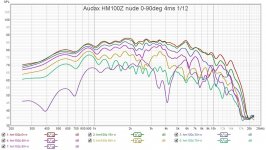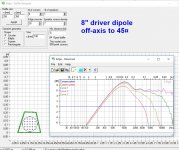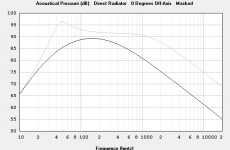I'm trying to pick a bass driver for a "micro-Manzinita" and I can't make heads or tails of the data I'm getting from the manufacturer vs out of Basta. I'm looking at the Goldwood GW-212/4 (1.2 Qts, black on the charts) & 12PC-4 (~0.4 Qts, red on the charts).
Here's the manuf data overlaid (in a 10 cu ft box):

Here's Basta data in a big box:

And here's Basta data on the 0.5x0.5m open baffle I'm planning (I will high pass around 200Hz or so):

What am I missing about the manufacturer's data? I will prob just get the GW-212/4 and call it a day.
Here's the manuf data overlaid (in a 10 cu ft box):
Here's Basta data in a big box:
And here's Basta data on the 0.5x0.5m open baffle I'm planning (I will high pass around 200Hz or so):
What am I missing about the manufacturer's data? I will prob just get the GW-212/4 and call it a day.
Basta appears to use theoretical models and it would not be the only currently used simulator to do that. One way you can tell is the breakup modes (may not have been included), these are not easy to model or work out from TS parameters. If you needed an excuse to take your own measurements... Of course getting polars is another. Simulating a baffle from manufacturer measured data is an in between compromise.
Whats the problem... a higher Qts driver will get you more bass compared to a higher one - both in the same environment. I see no surprises in the comparison. Absolute values - I dont know...
//
//
What's HR?True, but compared to HR, neither GW's or Basta's plots make sense other than the 212 makes a lot more (mid) bass, on axis gain BW.
I think I'm just gonna get the 212s.... cheaper and supposedly more sensitivity where I need it.
I honestly think you're focusing and looking at the wrong details.
I am not quite sure what a "micro-Manzinita" is, but a quick google search, shows me a little open-baffle speaker.
Assuming you're gonna use this just for low end of the freq resp, what is important is the cone excursion.
In a passive speaker also the Qt should be above roughly 0.65, as well as an adequate sensitivity.
Unfortunately we can only simulate the bafflestep and diffraction in BASTA (as an open baffle speaker), but NOT how a dipole actually behaves in the low end.
These days I would recommend Hornresp for that.
I am not quite sure what a "micro-Manzinita" is, but a quick google search, shows me a little open-baffle speaker.
Assuming you're gonna use this just for low end of the freq resp, what is important is the cone excursion.
In a passive speaker also the Qt should be above roughly 0.65, as well as an adequate sensitivity.
Unfortunately we can only simulate the bafflestep and diffraction in BASTA (as an open baffle speaker), but NOT how a dipole actually behaves in the low end.
These days I would recommend Hornresp for that.
OK I tried Hornresp and it pretty much confirms what Basta calculated.
I can't figure out how to get directivity results though.
I can't figure out how to get directivity results though.
It has a very comprehensive HELP file 😉, though personally find it hard to read, so I copy it to a Wordpad doc to customize to 'taste'.
From what I saw in the help file it didn't seem like it could do directivity plots on OB speakers, though I'm sure someone will let me know otherwise.
With Basta and Edge you can quickly simulate off-axis response by moving the mic and saving each plot. For OB sim, just toggle "Open baffle", below Mic distance!
Indoor measurements are very tricky, you have a lot to learn, better to google for instructions instead of asking every detail here, Measuring for a design software is much more tricky and detailed...
Basics:
https://acousticfrontiers.com/blogs...on-Specifications-and-Off-Axis-Response-Plots
https://www.soundstagenetwork.com/measurements/test_loudspeakers.htm
https://www.audioholics.com/loudspeaker-design/understanding-loudspeaker-measurements
More detailed:
https://www.klippel.de/know-how/mea...on/directional-radiation-characteristics.html
https://kimmosaunisto.net/
https://kimmosaunisto.net/Software/VituixCAD/VituixCAD_Measurement_REW.pdf
https://kimmosaunisto.net/Software/VituixCAD/VituixCAD_Measurement_ARTA.pdf
https://vcllabs.com/project04/


Indoor measurements are very tricky, you have a lot to learn, better to google for instructions instead of asking every detail here, Measuring for a design software is much more tricky and detailed...
Basics:
https://acousticfrontiers.com/blogs...on-Specifications-and-Off-Axis-Response-Plots
https://www.soundstagenetwork.com/measurements/test_loudspeakers.htm
https://www.audioholics.com/loudspeaker-design/understanding-loudspeaker-measurements
More detailed:
https://www.klippel.de/know-how/mea...on/directional-radiation-characteristics.html
https://kimmosaunisto.net/
https://kimmosaunisto.net/Software/VituixCAD/VituixCAD_Measurement_REW.pdf
https://kimmosaunisto.net/Software/VituixCAD/VituixCAD_Measurement_ARTA.pdf
https://vcllabs.com/project04/


Do off axis measurements matter for bass frequencies? Room interactivity is another reason why I'm not super pressed about directivity for bass drivers. I figure they just energize the room to a degree.
Depends on room size, speaker(s), listening, positions where bass is ~60-250 Hz, varying from a ~72" dia - ~17.25" dia. sound 'bubble', so a big deal to me; ditto in the 'sub' bass down to my ~22 Hz/16 ft wide sound wall, i.e. ideally we want to keep 1st reflections to beside/behind our ears, terminated into a diffusion zone (~71% room height book, knick case for me).
I'm trying to figure out of the speakers are worth building at all 🙂 Plus they are going to be portable so room measurements don't really make sense. They will be used indoors and outdoors kind of wherever I can fit them.Do your bass measurements in the room instead.
In that case I would just make a comparison list, a priority list as well as a budget.I'm trying to figure out of the speakers are worth building at all 🙂 Plus they are going to be portable so room measurements don't really make sense. They will be used indoors and outdoors kind of wherever I can fit them.
In the end it all depends on expectations.
If you want to compete with something like < $100 loudspeaker stereo set. The answer will be no probably.
That being said. Most cheaper loudspeakers aren't so bad. They just always seem to completely ruin and mess up the crossover filter for some reason.
- Home
- Loudspeakers
- Multi-Way
- I don't know what to believe (Basta vs manuf data)
